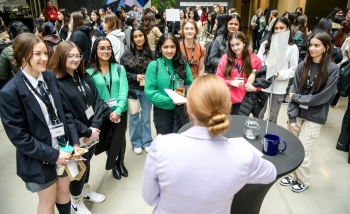From turbulent black holes and a new type of crystal to the meshing of art and science – plus a special section devoted to Convergence – here are some of the highlights from the Spring/Summer 2015 issue of Inside the Perimeter.
Science:
• Perimeter researchers decided to put a piece of science folklore to the test, and surprised themselves with the results: It appears that spacetime can be turbulent.
 • Dark matter is believed to be everywhere, but how can we actually detect it? Perimeter’s Maxim Pospelov suggests using atomic clocks like those in GPS satellites, while Asimina Arvanitaki hopes to use black holes to find the proposed QCD axion.
• Dark matter is believed to be everywhere, but how can we actually detect it? Perimeter’s Maxim Pospelov suggests using atomic clocks like those in GPS satellites, while Asimina Arvanitaki hopes to use black holes to find the proposed QCD axion.
• PI cosmologists Latham Boyle and Kendrick Smith propose a new kind of crystal – and show how one might be found.
Arts:
• Read, and watch, as we dig into the ephemera that sums up Carlo Rovelli, co-founder of loop quantum gravity and author of current Italian best-selling book Seven Brief Lessons in Physics, with his submission to the art exhibit Archive Fever.
• Take a front-row seat for Quantum: Music at the Frontier of Science, performed in May at the National Arts Centre in Ottawa.
• Check out the year’s Public Lecture Series highlights, and then watch the full presentations here.
Convergence:
To celebrate Convergence – Perimeter’s first alumni reunion – we asked a range of physicists for their take on the state of science today. Find out more about Convergence – and read their answers – here.
General:
• PI Kids Ask: How does a spinning egg stand on its pointy end?
• From the Black Hole Bistro: Is hot or cold brew coffee better?
Email us to subscribe to Inside the Perimeter magazine.
About PI
Perimeter Institute is the world’s largest research hub devoted to theoretical physics. The independent Institute was founded in 1999 to foster breakthroughs in the fundamental understanding of our universe, from the smallest particles to the entire cosmos. Research at Perimeter is motivated by the understanding that fundamental science advances human knowledge and catalyzes innovation, and that today’s theoretical physics is tomorrow’s technology. Located in the Region of Waterloo, the not-for-profit Institute is a unique public-private endeavour, including the Governments of Ontario and Canada, that enables cutting-edge research, trains the next generation of scientific pioneers, and shares the power of physics through award-winning educational outreach and public engagement.
You might be interested in




